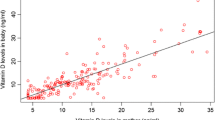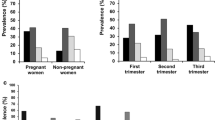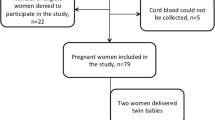Abstract
Purpose of the Study
The aim of the study was to determine the prevalence and risk factor for vitamin D deficiency in our pregnant population.
Method
A total of 418 healthy primigravida with single live pregnancy and sure of dates attending the antenatal clinic between October 2011 and April 2013 were recruited. Women were excluded if they had history of current or past chronic medical disease. Women were also excluded if they had history of medication with drugs interfering with calcium and vitamin D metabolism.
Results
The prevalence of vitamin D deficiency during pregnancy has been found to be 391 (93.5 %). Severe vitamin D deficiency among pregnant patients was 34.44 % (144/418). The levels of serum 25(OH)D and serum calcium were significantly lower in severe deficient group than the adequate group [7.10 ± 1.49 vs. 38.90 ± 4.22 ng/ml (p = 0.001) and 7.13 ± 1.41 vs. 9.39 ± 0.88 ng/ml (p = 0.001)], respectively. Maternal education, husband education, socioeconomic status, serum calcium, serum phosphorous, and season were significant factors associated with vitamin D deficiency. Significant independent variables for severe vitamin D deficiency were low serum calcium, serum alkaline phosphatase, and serum phosphorus (OR 39.41, 95 % CI 10.30–150.85, p < 0.01), (OR 18.03, 95 % CI 3.95–82.44, p < 0.01), and (OR 8.40, 95 % CI 2.47–28.61, p < 0.01).
Conclusion
Vitamin D deficiency is highly prevalent among pregnant women in Northern India, and these raises concern about the health consequences for the mother and the offspring.
Similar content being viewed by others
References
Harinarayan CV, Joshi SR. Vitamin D status in India-its implications and remedial measures. J Assoc Physicians India. 2009;57:40–8.
Hollick MF. Vitamin D deficiency. N Engl J Med. 2007;357(266–281):3.
Holick MF, Binkley NC, Bischoff-Ferrari HA, et al. Evaluation, treatment, and prevention of vitamin D deficiency: an endocrine society clinical practice guideline. J Clin Endocrinol Metab. 2011;96:1911–30.
Javaid M, Crozier S, Harvey N, et al. Maternal vitamin D status during pregnancy and childhood bone mass at 9 years: a longitudinal study. Lancet. 2006;367:36–43.
Sachan A, Gupta R, Das V. High prevalence of vitamin D deficiency among pregnant women and their new borns in northern India. Am J Clin Nutr. 2005;81:1060–4.
Judkins A, Eagleton C. Vitamin D deficiency in pregnant New Zealand women. N Z Med J. 2006;119:4227 (U2144 Nutrients 2012).
Shibata M, Suzuki A, Sekiya T, et al. High prevalence of hypovitaminosis D in pregnant Japanese women with threatened premature delivery. J Bone Miner Metab. 2011;29:615–20.
Van Der Meer IM, Karamali NS, Boeke AJ, et al. High prevalence of vitamin D deficiency in pregnant non-western women in the Hague, The Netherlands. Am J Clin Nutr. 2006;84:350–3.
Dasgupta A, Saikia UK, Sarma D. Status of 25(OH) D levels in pregnancy: a study from the North Eastern part of India. Indian J Endocrinol Metab. 2012;16(Suppl 2):S405–7.
Krishnaveni GV, Veena SR, Winder NR, et al. Maternal vitamin D status during pregnancy and body composition and cardiovascular risk markers in Indian children: the Mysore Parthenon study. Am J Clin Nutr. 2011;93(3):628–35.
Marwaha RK, Tandon N, Chopra S, et al. Vitamin D status in pregnant Indian women across trimesters and different seasons and its correlation with neonatal serum 25-hydroxyvitamin D levels. Br J Nutr. 2011;106:1383–9.
Harinarayan CV, AlokSachan P, Amaresh Reddy KM, et al. Vitamin D status and bone mineral density in women of reproductive and postmenopausal age groups: A cross-sectional study from South India. J Assoc Physicians India. 2011;59:695–701.
Aghajafari Fariba, Nagulesapillai Tharsiya, Ronksley PE, et al. Association between maternal serum 25-hydroxy vitamin D level and pregnancy and neonatal outcomes: systematic review and meta-analysis of observational studies. BMJ. 2013;346:1169.
Ravi Kumar BP, Dudala SR, Rao AR. Kuppuswamy’s Socio-economic status scale—a revision of economic parameter for 2012. IJDRH. 2013;1:2–4.
Milman N, Hvas AM, Bergholt T, et al. Vitamin D status during normal pregnancy and postpartum. A longitudinal study in 141 Danish women. J Perinat Med. 2011;40:57–61.
Babu US, Calvo MS. Modern India and the vitamin D dilemma: evidence for the need of a national food fortification program. Mol Nutr Food Res. 2010;54:1134–47.
Dror DK. Vitamin D status during pregnancy: maternal, fetal, and postnatal outcomes. Curr Opin Obstet Gynecol. 2011;23:422–6.
Dror DK, Allen LH. Vitamin D inadequacy in pregnancy: biology, outcomes, and interventions. Nutr Rev. 2010;68:465–77.
Acknowledgments
This study was funded and supported by Maulana Azad Medical College, New Delhi, India.
Compliance with ethical requirements and Conflict of interest
All procedures performed in studies involving human participants were in accordance with the ethical standards of the institutional and/or national research committee and with the 1964 Helsinki declaration and its later amendments. Authors declare that they have no conflict of interest.
Author information
Authors and Affiliations
Corresponding author
Rights and permissions
About this article
Cite this article
Sharma, S., Kumar, A., Prasad, S. et al. Current Scenario of Vitamin D Status During Pregnancy in North Indian Population. J Obstet Gynecol India 66, 93–100 (2016). https://doi.org/10.1007/s13224-014-0658-5
Received:
Accepted:
Published:
Issue Date:
DOI: https://doi.org/10.1007/s13224-014-0658-5




